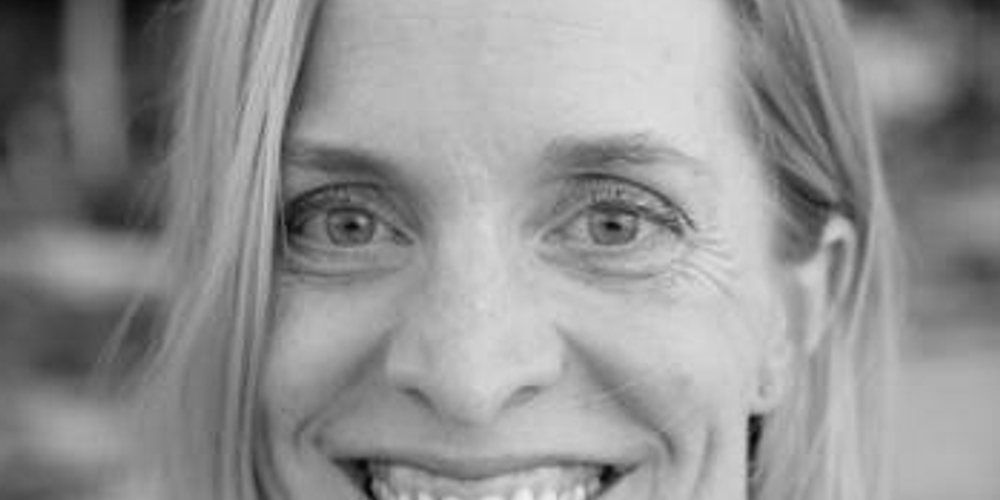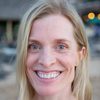Yogiraj (Yoga Master) Katrina Repka has been studying yoga since 1990 and teaching since 2001. Her early training in her hometown of Calgary, Canada, was in the Ashtanga style, but she moved to New York in 2001 and became immersed in the study of ISHTA Yoga under the guidance of Alan Finger. Katrina teaches ISHTA workshops and retreats all over the world, but is based in London, UK where she leads teacher trainings, classes, and workshops. Katrina holds a BA and MSC (Communications), and is the co-author (with Alan Finger) and featured model of Chakra Yoga: Balancing Energy for Physical, Spiritual, and Mental Well-being, and Breathing Space: Twelve Lessons for the Modern Woman. She has been featured in numerous publications including Vogue, Elle, the Guardian and the Daily Telegraph, and as a yoga expert on BBC TV and radio.
1. What, when and where was your first experience of yoga?
The first yoga class I ever went to was in my hometown of Calgary, Canada. I was in my first year of university, and every Friday was “Loonie Friday” - you paid one Canadian dollar (called a Loonie) to get in. I won’t say I was a Loonie to go, even though the teaching was not that great, in hindsight, because I stayed (and went again). But - before that class, a long time before - I’d say my first experience of yoga was in the park with my mother. I was perhaps three years old. I remember the sunlight, the leaves on the branches, the clouds sailing across a blue sky. I felt the grass under my feet. I just stood there and marvelled at it all. I felt connected. That, in my opinion, is what yoga does.
2. What made you decide to move from student to teacher?
I never set out to be a yoga teacher. My first yoga teacher training - in ashtanga yoga in Calgary - came about as a swap: the owner of the studio where I had been practising for some years asked me to write a teacher-training manual (I have a Master’s in Communications), and that required me to be a student on his course. I looked on the offer as an opportunity to deepen my practice, and participating in that training awakened in me a desire to know more. Not long after - in August, 2001 - I moved to New York to be with my partner and to teach at the Fashion Institute of Technology.
I had been in NY for two weeks when 9/11 happened. I was living quite close to the towers and was there during the whole ghastly event and its aftermath. It shook me up, I can tell you. A challenging and traumatic time. I needed my yoga to calm me down, and (like everybody else in Manhattan, it seemed) I wanted to connect with others; the burden of what we had all witnessed was too great to manage on one’s own. By chance, on my daily walk, I noticed Alan Finger’s yoga studio; even more coincidentally, I had just been reading about him in New York Magazine. I went inside; a teacher-training course - which had been delayed because of 9/11 - was about to start. I asked about a place, and at that very moment one of the studio owners, who had been listening to my conversation with the receptionist, asked me if I would like to do the course for free in exchange for co-authoring a book on the chakras with Alan Finger! Talk about karma. I agreed without hesitation and that began my close cooperation with Alan, which is now - I can’t quite believe it - in its seventeenth year. I finished the course and started teaching yoga and writing about it.
So I cannot truthfully say that the decision to graduate from student to teacher was any of my doing. The Universe had a plan for me.
3. What teaching tip has had the biggest influence on the way you practise?
Practise every day; consistency and application are the bridge that connects you to the Divine. Or, to put it another way (as the great choreographer, George Balanchine, counsels): “Do the Work”.
And the way you teach?
Keep out of your own way! Don’t let your ego dominate. Remember that you are merely a channel for the teachings to move through you.
4. What does your own self-practice involve?
Every day I do at least 35 minutes of practice, which consists of ten minutes of pre-meditative asana followed by 22 minutes of pranayama and meditation, and three minutes of regrounding. It is very precise! Most days I also do 15-25 minutes of post-meditative asana. And every so often I will do a 90-minute extended practice with a bit more asana and some Yin or Restorative postures.
5. If you only had 10 minutes to practise, what would you do?
Four and a half years ago, I made a promise to myself that I would meditate every day, so I always earmark at least 35 minutes for that. Alan Finger has only missed seven days of meditation in 55 years and says that you can always get up a bit earlier to make the time for the practice, and even though I continue to encounter my own resistance, I have found this to be true. So, I would say that for me 35 minutes is the minimum. However, it has taken me almost 30 years to get to this point, so for someone newer to yoga I would recommend doing some ujjayi breath with cat/cow, downdog, a few sun breaths and tree pose. That would be an admirable ten-minute stint.
6. Who/what is the biggest inspiration on your yoga journey at the moment?
My students and my family are always my greatest inspiration. And Alan, of course. He is always there, in my heart and mind, guiding me forward.
7. What role does yoga play in the way you live?
Yoga is the tether that releases me, the harness that liberates me. It gives my life definition. I do my practice and trust that life is unfolding as it should.
8. What do you hope your students experience when they practise with you?
I always strive to give my students the truest experience of yoga, which I consider to be the harmonious connection of body, mind, and spirit. I have faith that through yoga my students will live happier, freer lives.
9. Which yoga text could you not live without?
I love the Sutras. Wisdom in the form of poetry.
10. What’s your favourite yoga pose to do and to teach?
It’s a toss-up between downdog and tree pose!
11. Describe the meaning of yoga in 10 words or less.
Becoming One with yourself through personal transformation and self-realisation.


